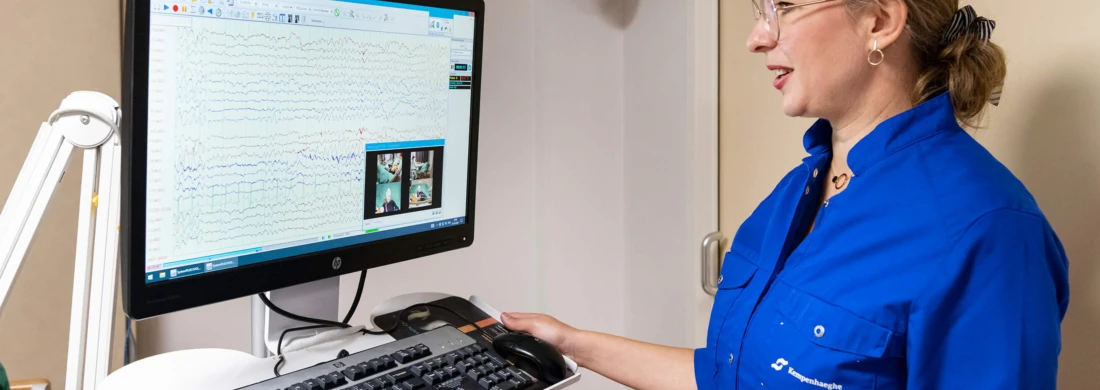EEG Examination
The purpose of an EEG examination is to measure the brain's electrical activity and detect abnormal patterns.
EEG stands for Electroencephalogram. Small electrodes are placed on your head, and sometimes on other parts of the body. This is not painful, though it may be a bit uncomfortable.
Kempenhaeghe uses various forms of EEG recording, such as for seizure recording. Some forms of EEG recording last longer than others. Some take place during the day, while others are done at night. For one type of examination, you may need to stay awake overnight, while for another, that isn't necessary. In some cases, you can go home after the electrodes are placed and return the next day for electrode removal. For other forms, you may need to stay at Kempenhaeghe for several days, and sometimes video recordings are made. Sometimes, you will need to keep a diary, but this is not always required.
Before the examination, you will receive detailed information about the form of EEG recording that applies to you. This will include information about the procedure and practical matters to consider. On the children's website www.kempenhaeghekids.nl, there is additional explanation available in the form of a picture book under ‘Draadjes op hoofd’ for children.
MRI Examination
An MRI examination allows the doctor to see if any abnormalities in the brain could be causing your symptoms.
MRI stands for Magnetic Resonance Imaging. An MRI can produce very clear images of the brain using magnetic fields. The MRI scan provides a series of cross-sectional images of the head and brain. The doctor can then determine if there are any abnormalities, such as damage, scarring, a developmental disorder, or a tumor.
MRI examinations are painless and require no special preparation. At Kempenhaeghe, you will lie on an examination table, and a plastic holder will be placed over your head. Staying still is very important! You can communicate with the technician through a microphone in the MRI tunnel.
During the examination, you will hear a tapping sound. You will be given earplugs or headphones with music to reduce the noise. When the sound stops, one set of images is complete. Taking a set of images can take anywhere from half a minute to over ten minutes. Typically, the examination consists of multiple sets of images.
For patients who cannot lie still (such as young children or individuals with intellectual disabilities) or those who find lying in the MRI tunnel very frightening, there is the option of having an MRI under anesthesia.
Before the examination, you will receive detailed information about the type of MRI examination that applies to you. You will also learn about the procedure and any practical matters to consider. On the children's website www.kempenhaeghekids.nl, there is additional explanation for children available in the form of videos under ‘Research/Photo of your brain’.
Neurological Examination
A (pediatric) neurological examination consists of an in-depth conversation with the (pediatric) neurologist about the reason for the visit, and if necessary, a physical examination to check the key functions of the nervous system.
The neurological examination is non-invasive. The (pediatric) neurologist observes and tests the senses, motor skills, and coordination, and assesses the reflexes.
Neuropsychological and Psychological Examination
A neurological condition (including epilepsy) may be associated with issues such as problems with language, memory, or concentration. It can also impact an individual’s self-image or mood. It is not uncommon for questions to arise regarding the acceptance of the effects of the condition(s) on aspects like living, working, parenting, learning, and relationships.
These factors may lead to the involvement of a behavioral scientist. At Kempenhaeghe, various types of behavioral scientists with their own specializations are available. For both children and adults, neuropsychological, clinical psychological, or neurodidactic assessments can be used to map the issues at hand.
A neuropsychological examination consists of an intake (for children, this also involves the parents) and the administration of tests. The tests include answering questions, solving tasks, measuring response speed, and completing memory and attention tests. The assessment may also examine mood, personality, and acceptance of the condition. The tests are administered over one or two half-days by a psychological assistant. In some cases, the neuropsychologist may be present for part of the time. With your consent, video recordings may also be made to assist the diagnosis.
The behavioral scientist evaluates the tests and provides the results to the treating neurologist, who will discuss the results with you. In certain cases, the behavioral scientist will also be present during this discussion.
Before the (neuro)psychological examination, you will receive information about the procedure, practical matters to consider, and your rights and responsibilities related to the examination.
Nursing Observation
During a stay at Kempenhaeghe, nurses observe the patient.
Nursing observation can help gain insight into factors that influence the condition and how it manifests. Sometimes, the observation is also focused on behavior.
